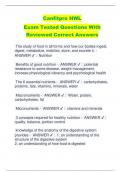Canfitpro HWL
Exam Tested Questions With
Reviewed Correct Answers
The study of food in all forms and how our bodies ingest,
digest, metabolize, mobilize, store, and excrete it. -
ANSWER ✔ : Nutrition
Benefits of good nutrition - ANSWER ✔ : potential
resistance to some disease, weight management,
increase physiological vibrancy and psychological health
The 6 essential nutrients - ANSWER ✔ : carbohydrates,
proteins, fats, vitamins, minerals, water
Macronutrients - ANSWER ✔ : Water, protein,
carbohydrates, fat
Micronutrients - ANSWER ✔ : vitamins and minerals
3 concepts required for healthy nutrition - ANSWER ✔ :
quality, balance, portion control
knowledge of the anatomy of the digestive system
provides - ANSWER ✔ : 1. an understanding of the
structure of the digestive system
2. an understanding of how food is digested
,3. an understanding of how food and toxins can stress the
digestive system
The 2 components of the digestive system - ANSWER ✔
: The digestive tract and the accessory organs
an open system through which food passes to be broken
down, used, or excreted - ANSWER ✔ : digestive tract
____ connect to the digestive tract and provide some of
the critical elements that allow for the breakdown of food
for absorption and/or excretion - ANSWER ✔ : accessory
organs of digestion
Anatomy of Digestive Tract - ANSWER ✔ : mouth,
esophagus, stomach, small intestine, large intestine,
rectum, anus
Where food enters and digestions begins mechanically
through chewing and chemically with saliva; mainly
carbohydrate - ANSWER ✔ : Mouth
Links the mouth to the stomach - ANSWER ✔ :
Esophagus
where food is both mechanically and chemically broken
down; primarily protein - ANSWER ✔ : stomach
, where food is both mechanically and chemically broken
down and then absorbed into the bloodstream - ANSWER
✔ : small intestine
where bacteria continue to breakdown whatever is left of
the food and where water is extracted, forming feces -
ANSWER ✔ : large intestine
where feces are stored - ANSWER ✔ : Rectum
where waste exits the body - ANSWER ✔ : anus
Anatomy of Accessory Digestive Organs - ANSWER ✔ :
salivary glands, liver, gallbladder, pancreas
glands in the mouth that secrete saliva, which contains
enzymes that begin the breakdown of carbohydrates -
ANSWER ✔ : salivary glands
The ____ produces bile, used in the breakdown of fat,
which is stored in the gallbladder. It also serves as the
major detoxification organ of the body, where the nutrient
rich blood is sent for detoxification prior to use in the body.
- ANSWER ✔ : liver
A muscular sac attached to the liver that secretes bile and
stores it until needed for digestion - ANSWER ✔ :
Gallbladder
The number of fat cells we have remains constant after
adolescence and cannot be eliminated. We do have the
, capacity to increase or decrease their size through _____.
- ANSWER ✔ : caloric intake
BMI over 25 - ANSWER ✔ : Overweight
BMI over 30 - ANSWER ✔ : Obesity
Number of adults considered to be overweight or obese -
ANSWER ✔ : More than 2 in 3
Number of adults considered to be obese - ANSWER ✔ :
More than 1 in 3
Number of adults considered to be extremely obese -
ANSWER ✔ : More than 1 in 20
Total weight consists of - ANSWER ✔ : Water mass, fat
mass, and fat-free mass
fat located under the skin - ANSWER ✔ : Subcutaneous
fat
Fat that accumulates in areas such as the back of the
arms, above each hip ("love handles"), the sides of the
back just below the shoulder blades, the abdomen, the
buttocks, and the thighs. Undesirable, but not necessarily
dangerous to health. - ANSWER ✔ : Subcutaneous




